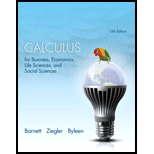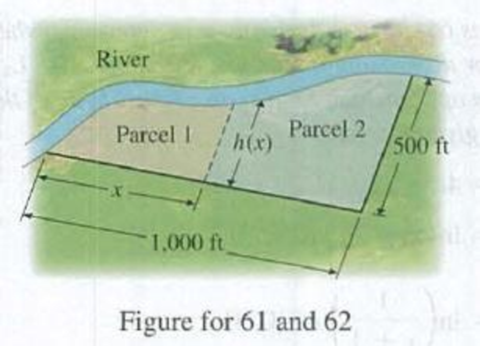
Concept explainers
Problems 61 and 62 refer to the following figure showing two parcels of land along a river:

61. You want to purchase both parcels of land shown in the figure and make a quick check on their combined area. There is no equation for the river frontage, so you use the average of the left and right sums of rectangles covering the area. The 1,000-foot baseline is divided into 10 equal parts. At the end of each subinterval a measurement is made from the baseline to the river, and the results are tabulated. Let x be the distance from the left end of the baseline and let h(x)
be the distance from the baseline to the river at x. Use L10 to estimate the combined area of both parcels, and calculate an error bound for this estimate. How many subdivisions of the baseline would be required so that the error incurred in using Ln would not exceed 2,500 square feet?
| x | 0 | 100 | 200 | 300 | 400 | 500 |
| h(x) | 0 | 183 | 235 | 245 | 260 | 286 |
| x | 600 | 700 | 800 | 900 | 1,000 |
| h(x) | 322 | 388 | 453 | 489 | 500 |
Want to see the full answer?
Check out a sample textbook solution
Chapter 5 Solutions
Calculus for Business Economics Life Sciences and Social Sciences Plus NEW
- 4. Solve the system of equations and express your solution using vectors. 2x1 +5x2+x3 + 3x4 = 9 -x2+x3 + x4 = 1 -x1-6x2+3x3 + 2x4 = -1arrow_forward3. Simplify the matrix expression A(A-B) - (A+B)B-2(A - B)2 + (A + B) 2arrow_forward[2 pts] 1. Let A = [. 1 -1 0 -343 and B = 05 5 -7 304 Compute (7A - 3B) - 4(2A - B).arrow_forward
- 20 2. Let A = = [ -2 0 1 3 ] and B = 2 3 -1 2 For each of the following, calculate the product or indicate why it is undefined: (a) AB (b) BAarrow_forwardTrue or False and whyarrow_forward10 5 Obtain by multiplying matrices the composite coordinate transformation of two transformations, first x' = (x + y√√2+2)/2 y' = z' (x√√2-2√2)/2 z = (-x+y√√2-2)/2 followed by x" = (x'√√2+z'√√2)/2 y" = (-x'y'√√2+2')/2 z" = (x'y'√√2-2')/2.arrow_forward
- Not use ai pleasearrow_forward4 The plane 2x+3y+ 6z = 6 intersects the coordinate axes at P, Q, and R, forming a triangle. Draw a figure and identify the three points on it. Also find vectors PQ and PR. Write a vector formula for the area of the triangle PQR and find its value.arrow_forward3.1 Limits 1. If lim f(x)=-6 and lim f(x)=5, then lim f(x). Explain your choice. x+3° x+3* x+3 (a) Is 5 (c) Does not exist (b) is 6 (d) is infinitearrow_forward
- 1 pts Let F and G be vector fields such that ▼ × F(0, 0, 0) = (0.76, -9.78, 3.29), G(0, 0, 0) = (−3.99, 6.15, 2.94), and G is irrotational. Then sin(5V (F × G)) at (0, 0, 0) is Question 1 -0.246 0.072 -0.934 0.478 -0.914 -0.855 0.710 0.262 .arrow_forwardAnswer the number questions with the following answers +/- 2 sqrt(2) +/- i sqrt(6) (-3 +/-3 i sqrt(3))/4 +/-1 +/- sqrt(6) +/- 2/3 sqrt(3) 4 -3 +/- 3 i sqrt(3)arrow_forward2. Answer the following questions. (A) [50%] Given the vector field F(x, y, z) = (x²y, e", yz²), verify the differential identity Vx (VF) V(V •F) - V²F (B) [50%] Remark. You are confined to use the differential identities. Let u and v be scalar fields, and F be a vector field given by F = (Vu) x (Vv) (i) Show that F is solenoidal (or incompressible). (ii) Show that G = (uvv – vVu) is a vector potential for F.arrow_forward
 Glencoe Algebra 1, Student Edition, 9780079039897...AlgebraISBN:9780079039897Author:CarterPublisher:McGraw Hill
Glencoe Algebra 1, Student Edition, 9780079039897...AlgebraISBN:9780079039897Author:CarterPublisher:McGraw Hill Algebra: Structure And Method, Book 1AlgebraISBN:9780395977224Author:Richard G. Brown, Mary P. Dolciani, Robert H. Sorgenfrey, William L. ColePublisher:McDougal Littell
Algebra: Structure And Method, Book 1AlgebraISBN:9780395977224Author:Richard G. Brown, Mary P. Dolciani, Robert H. Sorgenfrey, William L. ColePublisher:McDougal Littell
 Holt Mcdougal Larson Pre-algebra: Student Edition...AlgebraISBN:9780547587776Author:HOLT MCDOUGALPublisher:HOLT MCDOUGAL
Holt Mcdougal Larson Pre-algebra: Student Edition...AlgebraISBN:9780547587776Author:HOLT MCDOUGALPublisher:HOLT MCDOUGAL Mathematics For Machine TechnologyAdvanced MathISBN:9781337798310Author:Peterson, John.Publisher:Cengage Learning,
Mathematics For Machine TechnologyAdvanced MathISBN:9781337798310Author:Peterson, John.Publisher:Cengage Learning, Trigonometry (MindTap Course List)TrigonometryISBN:9781305652224Author:Charles P. McKeague, Mark D. TurnerPublisher:Cengage Learning
Trigonometry (MindTap Course List)TrigonometryISBN:9781305652224Author:Charles P. McKeague, Mark D. TurnerPublisher:Cengage Learning





